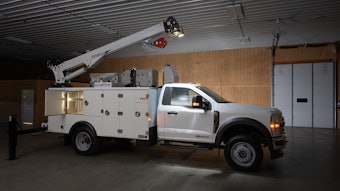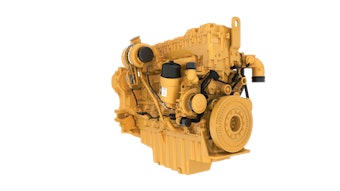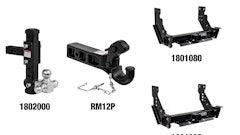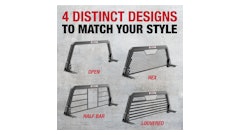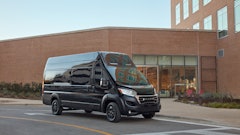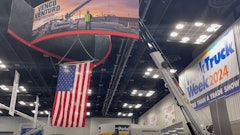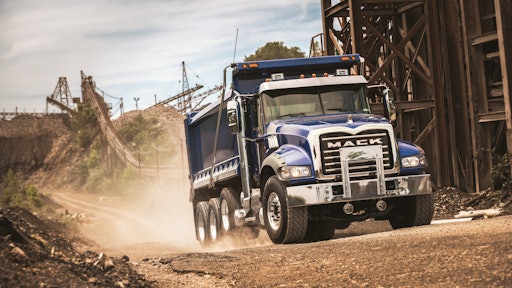
A shortage of qualified drivers, greenhouse gas (GHG) regulations, emerging collision mitigation technologies and telematics-driven uptime solutions are rapidly transforming the Class 7 and 8 vocational truck market.
An emphasis on driver retention is changing how trucks are spec’d. “There’s a focus on maximizing driver comfort and minimizing driver fatigue; providing trucks with a comfortable, quieter environment; spec’ing automated manual transmissions to attract newer drivers entering the industry; and choosing trucks with an eye to serviceability and uptime,” says Kurt Swihart, Kenworth marketing director.
Your future success depends on keeping drivers motivated. “Vocational users want to build lasting relationships with their drivers, and they want to make the profession as appealing as possible,” says Mary Aufdemberg, director of product marketing, Freightliner Trucks. “They are thinking about specs that will make drivers excited to be on the job, as well as productive.”
“Vocational operators need to deal with an aging driver workforce, and make driving trucks more appealing to a younger generation,” adds Swihart. “To be successful, we need to help them improve driver retention and reduce their operating costs. We see this trend not only continuing, but accelerating as more employees, particularly skilled drivers, retire or get closer to retirement.”
Technology is also changing the cost of ownership equation. “Customers are also thinking about the entire life cycle of their truck, so they are spec’ing safety features and fuel-efficient engines, and incorporating telematics solutions that reduce the real cost of ownership,”says Aufdemberg.
Automation Eases Driver Workload
“Both the on-highway and vocational segments continue to experience year-over-year growth in transmission [automation],” says Aufdemberg. “The technologies make drivers more productive and efficient. Automated manual transmissions (AMTs) have driver-friendly features that can make the experience better for the driver. AMTs are also good for drivers with less experience, so offering an AMT solution expands the driver pool.”
To appeal to a younger generation, spec’ing trucks with automatic and automated manual transmissions is an important incentive in attracting and retaining new drivers. But as Swihart points out, “Even among seasoned employees, trucks equipped with automatic and automated manual tranmissions are gaining wider appeal as they realize the benefits of finishing their shifts more refreshed.”
“Automated and automatic transmissions are becoming more popular due to reduced training time and reduced driver wear and tear,” says Peter Schimunek, vocational marketing manager, Western Star. “Anything that makes the day easier on the driver is going to see growth. AMTs contribute to increased productivity and provide smooth, effortless shifting in vocational applications. We are seeing a steady transition away from manuals, and while we can’t predict the future, there is little reason to think that trend will reverse.”
“To meet this trend, in 2015, we introduced a heavy-duty version of our proprietary AMT, the Mack mDRIVE HD,” says Tim Wrinkle, Mack Trucks construction product manager. “This year, Mack introduced two new variants of the mDRIVE HD with low ratio creeper gears. With the added capability of the creeper gears, the mDRIVE HD13 and 14-speed AMTs are well-suited to vocational applications and help improve low-speed maneuverability and startability under heavy loads.
“Currently, about 70% of our vocational models are spec’d with either a conventional automatic transmission or AMT, as operator preference has shifted that way,” he continues. “Mack still offers our Maxitorque manual transmission for customers whose applications require a manual, but we expect manual transmission penetration to decline.”
The demand for automatic and automated transmissions is changing the nature of the entire industry. “The shift away from manual transmissions has impacted the used truck market, as well, as we’ve seen trucks spec’d with automatics being much more desirable. We anticipate trucks spec’d with AMTs to follow suit,” says Wrinkle.
Navistar currently sees a pretty even split between manual transmissions and AMTs. “The AMTs cost more, but they speed up the driver learning curve,” says Steve Gilligan, vice president of product marketing, Navistar. “Sometimes it aids in attracting new or inexperienced drivers into a fleet. And from a fuel economy standpoint, the AMTs on average are better. The best driver with a manual can probably outperform an AMT, but that is not the norm.”
Even with the emergence of AMTs, the Allison automatic transmission still dominates the majority of Navistar vocational trucks. “Customers know it is relatively expensive and they know it is expensive to repair, but it is also very reliable and very durable,” says Gilligan. There are also performance advantages. “Customers are very loyal because the product has demonstrated its functionality over time.”
“With additional features that provide low-speed maneuverability and functionality more closely related to the benefits of full automatic transmissions — but at a lower cost point — AMTs are becoming a very valid option for markets like dump and ready-mix [trucks] that often utilized full automatic transmissions in the past,” says Swihart.
“Automated and automatic transmissions are spec’d in a significant share of Peterbilt trucks,” says Charles Cook, marketing manager for vocational products. “It grows annually and it will continue to grow, especially in the vocational segments. Fleet owners realize automated and automatic transmissions are more fuel efficient, easier to operate for less driver fatigue and improved safety, and allow them to select drivers from a larger pool of candidates. It helps mitigate the difference between an experienced operator and a driver new to the industry.”
Telematics Promise Increased Optime
Telematics really gained traction in the line-haul fleets but now promise to transform the vocational industry, as well.
“Vocational customers are using telematics data for route planning, to diagnose problems and to make service decisions,” says Aufdemberg. “This helps minimize downtime and reduces untimely trips to a shop for non-urgent issues. The Detroit Virtual Technician remote diagnostics solution is available for all Freightliner vocational truck models spec’d with Detroit engines.”
Western Star Trucks also come equipped with Virtual Technician when spec’d with Detroit engines. “With Virtual Technician, fleets and owner-operators know within minutes when their vehicles experience engine, aftertreatment and Detroit Assurance fault events, the severity of the fault and when, where and how to fix the issue causing the fault so they can make informed service decisions,” says Schimunek. “Twenty percent of engine and aftertreatment faults captured by Virtual Technician are ‘driver actionable’ issues that the driver can resolve without pulling into a service center, further increasing uptime.”
We have only scratched the surface on how telematics will transform the vocational industry. “The use of telematics solutions and GPS in vocational applications will better connect drivers, fleet managers and customers, and will drive the biggest efficiencies in the next several years,” says Wrinkle. “Mack’s GuardDog Connect telematics solution comes standard on our Granite and TerraPro concrete pumper models and allows us to proactively monitor vehicles for potential issues that may lead to unplanned downtime. If GuardDog Connect detects an issue, our Mack OneCall team is available to immediately contact the customer’s designated decision maker via Mack ASIST. Should the issue require service, our solution automatically confirms parts and service bay availability — all while the truck is still on the road.”
“Onboard diagnostics and truck telematics are making significant impacts on maximizing uptime, improving service management and keeping
fleets running smoothly and on schedule,” says Peterbilt’s Cook. “While relatively new to the trucking industry, the capability and functionality of connected truck technologies will grow exponentially in the coming years. The diagnostic and troubleshooting information will become more sophisticated and accurate to help service trucks faster and more efficiently.”
“Driver performance and information centers like the Kenworth Driver Performance Assistant, as well as remote diagnostics systems such as Kenworth TruckTech+, will also become more commonplace because they allow fleets to identify the root causes of fault codes more quickly,” says Swihart. “That technology enables vocational customers to get their trucks back on the road faster earning revenue.”
Navistar offers its OnCommand Connection telematics solution for every product it sells in any application. The solution is also compatible with any truck make currently in the fleet. “This allows the fleet director or maintenance manager to see fault codes and it allows them to mitigate downtime,” says Gilligan.
While all major fault codes are visible to the driver, fleets can prevent drivers from seeing minor fault codes that can prove distracting.
New Safety Features Emerge
Many innovations in the Class 8 line-haul market are migrating into vocational applications. “Probably the best example of this technology is collision mitigation,” says Gilligan. “All truck classes will benefit from collision mitigation. We are starting to see requests from specific on/off-highway vocational users who want that technology. It does work in those environments.”
Expect further safety systems to evolve in the near term. “Wider acceptance of safety systems is going to continue as a trend in the industry,” Aufdemberg comments. “We will continue to see additional active safety system features rolled out each year.” Features such as pedestrian recognition, cross-traffic recognition, roll stability and blind spot recognition are a few examples.
System integration is already enhancing current vehicle safety. “The Detroit Assurance suite of safety systems is fully integrated with Detroit engines and transmissions, as well as the truck’s braking system and dashboard, to enhance driver safety by mitigating collisions,” says Aufdemberg. “The full integration results in smoother and more fuel-efficient speed and braking transitions.”
Other technologies are also gaining traction. “In terms of safety technologies, roll stability and disc brakes are features that are gaining popularity with vocational customers,” says Wrinkle. “Camera systems are used regularly in [Mack’s] cabover TerraPro and LR models, as well.”
All vocational trucks that drive on the road could benefit from these systems. “The main challenge is ensuring these devices are able to survive the abuse that vocational jobsites unleash,” says Wrinkle. “Just keeping the safety devices clean in order to function properly could also be a challenge.” Vocational truck owners do not wish to complicate the work of the drivers or add hardware that could cause additional maintenance.
Peterbilt has made front air disc brakes and electronic stability control standard. “Those are among more than a dozen standard safety features that range from improving visibility to safer entry to and egress from the cab,” says Cook. “There is also a range of optional safety features, including the recently introduced Bendix Wingman Fusion, which integrates several advanced safety technologies to help mitigate rear-end collisions, provide speeding alerts, brake when stationary objects are approached and reduce the risk for rollovers, loss-of-control situations and side-swipe crashes. Vocational customers frequently spec for safety and we expect Bendix Wingman Fusion to be a popular option.”
Power Densities Provide Weight Savings
Over the last few years, there has been an emphasis on “right sizing” engines. “Engine technology has allowed us to extract more horsepower from smaller displacement engines,” says Wrinkle. For example, the new 435-hp rating for Mack’s MP7 engine essentially puts 13-liter power in an 11-liter engine. “The main benefits for customers choosing smaller displacement engines are improved fuel efficiency and reduced weight while maintaining power levels that are required to get the job done.”
The main shift has been from 15-liter to 13-liter engines. “There has been a greater focus on 13-liter engines as various manufacturers have increased the top ratings on these engines,” says Schimunek. “Improvements to fuel systems, aspiration and higher compression ratios have contributed to this. It is important to understand there are technical limitations to any engine, and that constantly running at the higher power ratings means that the engine will be operating closer to its design limit.”
Downsizing has its advantages. “We see downsizing in two main areas: reducing weight, and spec’ing for the right horsepower and torque rather than simply the highest available,” says Cook. “Every pound we can take out of a truck means another pound of payload. Unless you’re doing heavy-haul over 120,000 lbs. or need 600 hp, a 15-liter engine may not be necessary.”
“We continue to see more historically 15-liter customers converting to 13-liter engines,” says Swihart. “This is not only in on-highway applications. It also makes sense in those vocational applications where loads don’t often exceed 100,000 lbs. and truck operators can benefit from higher fuel economy and lower overall chassis weight. We are now starting to see vocational customers even switch from 13-liter to 11-liter power, spurred on by what we were able to accomplish with the new 2017 PACCAR MX-11 engine next year.” This 11-liter engine puts out up to 430 hp and 1,650 lbs.-ft. of torque.
A smaller engine may also help with aftertreatment performance. “The DPF and SCR systems want to work when hot, and oversizing an engine and never running it is one of the causes of aftertreatment failures,” says Swihart. “So really, sizing the right engine for the application is becoming even more important. Larger displacement engines still have their place in loads that are exceedingly heavy, such as lowboy or heavy-haul, but most vocational applications can easily use a 13-liter or even 11-liter engine to do the work needed.”
“Navistar was on the forefront of driving customers from 15 liters to 13 liters,” Gilligan asserts. “In 2010, we stopped offering 15-liter engines entirely.” But three years ago, the company re-introduced a 15-liter product. “There are some customers who are extraordinarily loyal to the 15-liter engines for durability and longevity, and there are other customers who have found that the 13 liter works for them. They like the weight savings, which is around 500 lbs. We think the majority of conversion [from 15-liter to 13-liter engines] has occurred.”
But expect the trend to smaller, lighter, more power-per-displacement engines to continue. For example, a ready-mix application may be able to move from a 13-liter engine to an 11.5-liter engine and save an extra 500 lbs.
“Any application where the weight determines your payload and your load payment is tied to that, it becomes very important,” says Gilligan.
However, there are practical limits. “There is a finite point where you just cannot get anymore horsepower and torque out of a certain block without sacrificing durability,” says Gilligan.
As power ratings continue to expand, it is really all about choice. “Rather than considering the engine landscape as going through a downsizing, it needs to be viewed as there being an expansion or wider selection of engine choices for a variety of applications,” says Schimunek. “The key toward selecting the right option is looking closely at load factors, duty cycles, GVW, weight sensitivity and other variables. Higher displacement engines will continue to have a variety of advantages in different applications such as durability and resale value.”




